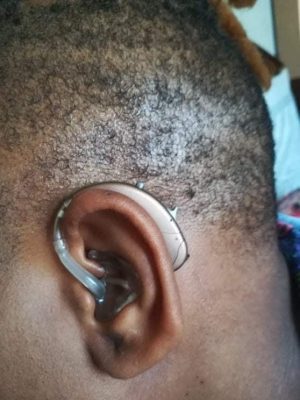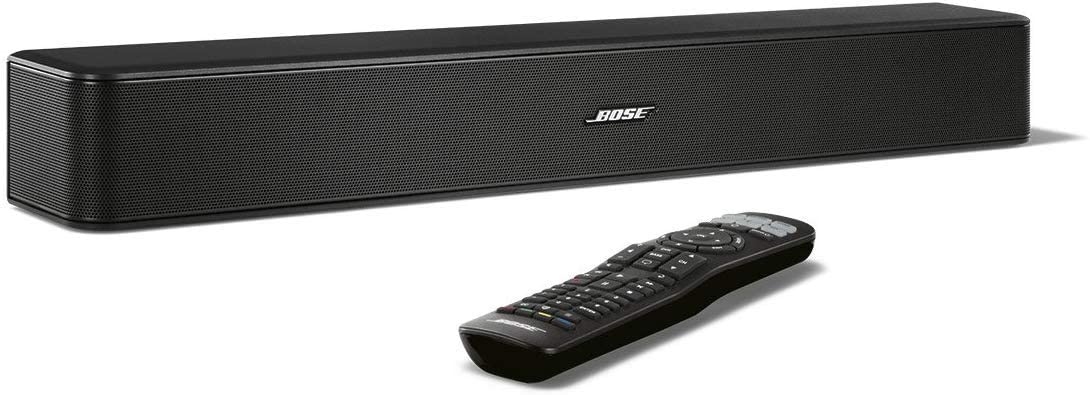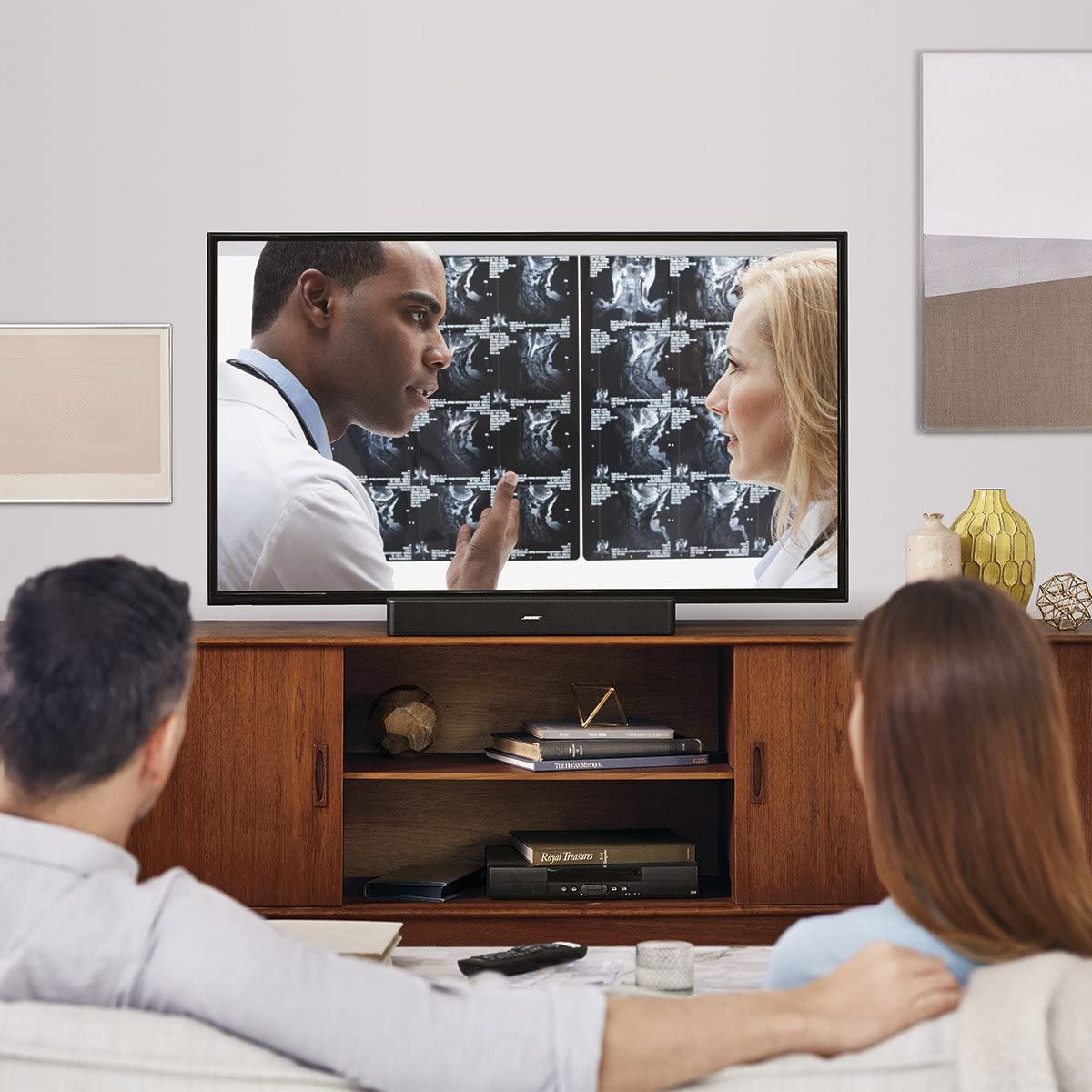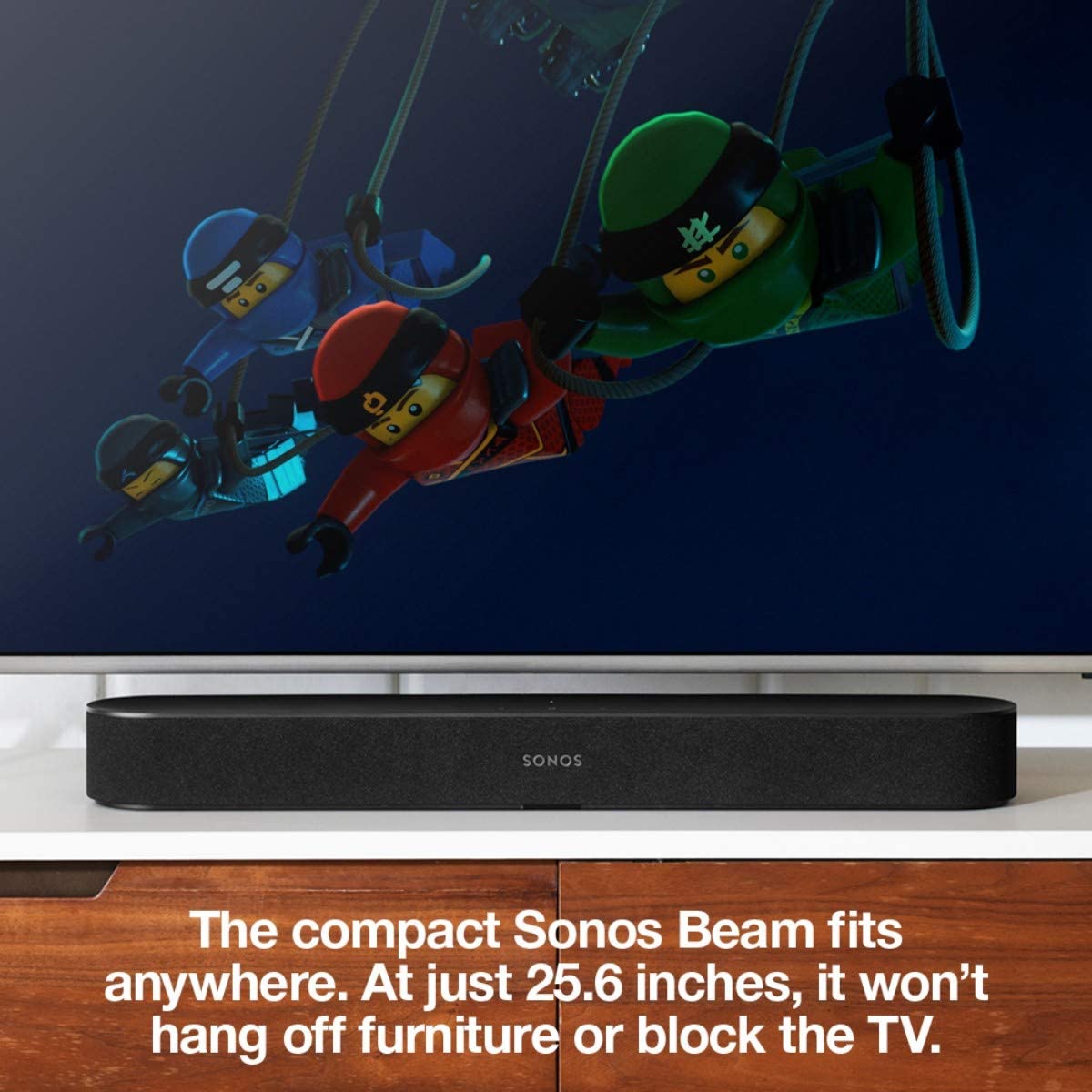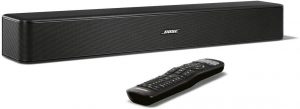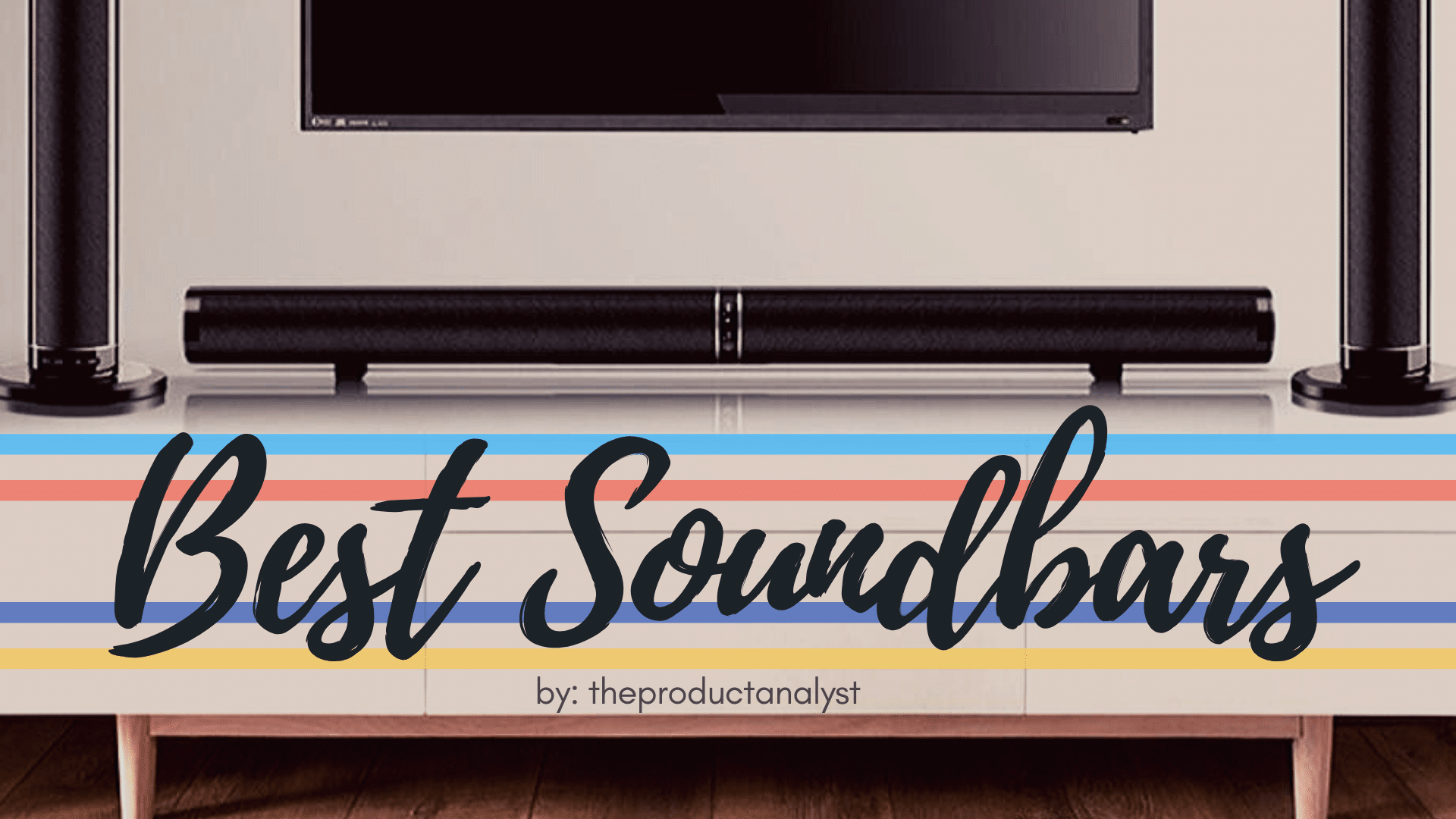
Soundbars are mini TV speakers than enhance your overall audio experience. They can range in price from a measly $50 for a budget soundbar to over $300 for a high-end one.
If you want something in the middle of this price range, read our article about the best soundbars under $200.
Some of the most advanced soundbars can exceed a couple thousand, like the Sennheiser Ambeo soundbar. The price affects the lifespan of the soundbar, quality of sound, and good features it comes with.
With TV’s boasting slimmer and slimmer build, it’s no wonder one needs additional support to optimize the sound. Movies are only as good as the audio effects, right?
We did the hard part for you. We have researched and tested some of the best soundbar options today, noting their best features, pros, and cons. Below is our top list for soundbars guaranteed to blow your mind.
7 Best Soundbars Reviews
1. VIZIO SB3821-C6 38-inch 2.1 Channel Soundbar

We start our list and review with one of the best soundbars on Amazon: VIZIO SB3821-C6. For just $150, the price is reasonable and the rich bass is impressive. The gist of every review we’ve read is positive. It is why people invest in a better speaker.
You get to enjoy great sounds throughout your living room space at 100 dB (decibels). The crystal clear sound of this Vizio model will possess less than 1% of harmonic distortion.
The Vizio wireless subwoofer of this best soundbar encompasses the full room with great sounds and audio. The deep bass will vibrate through the space you giving you full audio sensation.
Get the most out of your Vizio soundbar because it does provide Bluetooth and Wi-fi. Link it to your mobile devices and play music straight from the soundbar as well.
The full range of sound is a great 60 feet! Choose between two good channels and the wireless subwoofer will transform movies and tv shows into quite a full experience of sight and sound without the need to be connected physically.
Enjoy streaming of music from your Spotify and the wireless speaker setup leaves your home clutter-free. Not to mention the sleek Vizio bar design will fit right into your décor whether it be mounted on the wall or placed under your TVs base.
PROS:
- DTS TruSurround
- The slender exterior and compact size of the Vizio fits nicely in small spaces.
- Allows you to stream via Bluetooth, Wi-fi
- Wireless sub
- Wireless setup means much less clutter.
- Delivers up to 100 decibels of crystal clear sound quality
- Sub has an impressive reach of 60 feet!
- Comes with a wireless remote
- Settings panel is easy to access on the soundbar itself.
CONS:
- The speakers start to crackle a bit early on.
- No Atmos
- Turns off randomly
- Connection via Bluetooth is unstable.
Check Today’s Price
2. Bose Solo 5 TV Soundbar Sound System

You’ve probably read a review about this brand as Bose’s reputation precedes them. They create wonderful headphones and speakers, and now we introduce the Bose soundbar.
The sleek and compact soundbar delivers better sound quality than the average built-in TV speakers, especially with stereo content. This is due to the advanced technologies the audio system possesses.
You will hear every full detail from a pin drop to an explosion. Never again will you miss bits of dialogue. The best part you’d want to see is the level of the bass can even be controlled with this bar. Unleash great bass with a simple touch of a button.
The bar can also decode Dolby Digital through its optical digital port.
Depending on the placement, you may choose to buy the compact soundbar alone, or with the wall mount or TV sound system. With just one connection to your TV, the soundbar is surprisingly easy to hook up so there’s less work.
You can use connections including the optical digital, coaxial digital, or analog inputs. It has no HDMI though. Read and check the manual if you need any help with inputs.
With Bluetooth, you’ll see you can stream music from your new toy seamlessly from your mobile devices.
To better handle this best soundbar, the included universal remote also allows you to set the bass, Bluetooth and sound to your preferred settings.
The lightweight soundbar is easily portable, so you may use it with more than one TV. Just simply plug it in and go for easy setup and use. Overall, this is one of the best soundbars around.
PROS:
- Just the sleek design alone deserves a spot on the pro list. It’s lightweight and relatively small in size (21.6 inches) in length, it’s easy to move around.
- Just the bar alone provides you with better sound than your built-in speakers, especially with stereo content
- Get crystal clear sound and never miss a single word or detail again.
- Wireless Bluetooth links to your mobile gadget for music streaming.
- With just one connection to the TV, setup is a snap.
- Universal remote gives you full access to all the settings with just the push of a few buttons.
- Buy the wall mount or full TV sound system if you wish.
CONS:
- Doesn’t work as well as other Bose products
- The volume isn’t quite as expected
- No Atmos
- No HDMI
Check Today’s Price
3. Nakamichi Shockwafe Pro 7.1.4 Channel 600W Dolby Atmos Soundbar

For serious technological fanatics out there, we present the Nakamichi Shockwafe in this review. With 7.1.4 channels, you know what you are paying or with the heftier price tag. For better deals, it’s always worth it to wait for Black Friday sale every November.
The 600W Dolby Atmos and DTS x sounding bars are on sale now! Dolby Atmos is one of the things that makes this soundbar best for your home. They have an option of the Ultra 9.2 channel Nakamichi Shockwafe as well.
The excellent Dolby Atmos soundbar has with features including an 8-inch subwoofer and TWO rear speakers that deliver the true sound experience. You can connect up to 6 devices with 3 HDMI inputs, 1 HDMI arc, and the optical and coaxial inputs.
With 3 advanced processing engines pump out sound that fills a room, this will provide you with a full theater feel.
Unlock any audio details you may have missed before in your favorite movies, tv shows, or music with 105 decibels of sound, even when just watching normal tv shows.
With the extra 2-way rear speakers, you will be met with full sound effects that resemble surround sound that other soundbars cannot deliver.
Are you a great lover of deep bass? This is also one of the best soundbars if you want that kind of audio. Great speakers pump out rich bass that bounces off the walls creating a hot box of sound that is absorbed directly into your eardrums.
It connects easily to your TV via optical digital or coaxial inputs and Dolby vision and 4K pass-throughs.
PROS:
- With this quite expensive price tag you get great theater-grade surround sound excellent in your living room.
- There are 7.1.4 audio channels.
- The shockwave possesses 2 2-way rear speakers that other soundbars do not.
- Offers Dolby Atmos and DTS x – great for movies
- Excellent home theater experience with Dolby Atmos
- Comes with a big 8-inch sub that delivers incomparable deep rich bass sounds.
- 3 HDMI inputs
- Advanced connectivity in the form of optical digital or coaxial inputs and Dolby vision and 4K pass-throughs, as opposed to the usual HDMI arc.
CONS:
- Non-existing customer support
- Becomes unresponsive quickly.
- Difficult to set up.
Check Today’s Price
4. Yamaha YAS-207BL Sound Bar

The first soundbar with DTS Virtual X 3D surround sound. The first soundbar that is able to produce real surround effect, better than your TV speakers.
With a slim and sleek form, it will not only complement your living room interiors, but also your TV as well.
This good bar has a good and powerful bass that can be felt and delivers clear sound that brings dialogue to the top and won’t drown it out with sound effects.
It has a quick setup with an optical cable for 4k or HDMI arc cable for HDMI input. You can also use the free compatible app so you can set up your TV easily on the couch. You can use the controller application on your mobile device.
Stream music from this great soundbar by using the built-in Bluetooth (like in the Yamaha YAS-209) to get higher audio quality.
It’s the first soundbar to offer the full surround sound quality audio without the complexity of multiple speakers. You’ll find that it’s great for movies!
PROS:
- Immerse yourself in clear lifelike audio effects in movies or shows with DTS Virtual X
- It features easy setup with an optical cable for 4k or HDMI arc cable for HDMI inputs.
- The first soundbar to offer surround sound-like experience, which makes the audio a standout.
- Slim and sleek design is understated and complements your TV.
- Wireless Bluetooth streaming allows you to get more out of your music apps.
CONS:
- Sound wavers and is also a bit unstable.
- Subwoofer cuts out often.
- The model is without a long lifespan.
Check Today’s Price
5. Sonos Beam – Smart TV Soundbar

With smart home technology, it was only a matter of time before a smart soundbar became available on the market. You can choose to buy the set or just the Sonos Beam soundbar itself to improve the sound from your TV speakers.
A bonus we love about this Sonos option is that these best soundbars come in two good color choices. Take your choice of white or black depending on your inner décor or what you like.
The small and compact soundbar is ready to enhance your TV, music and overall listening experience. It’s small in size and even cheaper than the famous Sonos Playbar, but Sonos Playbar still offers more benefits than the Sonos Beam.
But for its price, the Sonos Beam already a pretty good soundbar.
You can control the Sonos speakers by using the compatible device application or with its voice command feature.
Amazon Alexa is built into the Sonos smart soundbar to make your life easier. You can ask questions, give full commands and receive great information completely hands-free in this voice assistant. Voice control is the future of the best soundbars and speakers.
The easy setup process of the Sonos Beam can be done in even less than 5 min, you can start listening in no time.
The Sonos Beam is wall mountable, includes Apple Airplay 2, and speech enhancement.
PROS:
- Amazon Alexa built-in
- Give commands, and ask questions hands-free.
- It is wall mountable to save space.
- With speech enhancement, you will hear each spoken word and sound effect clearly all the time
- Easy to set up and use
- Beautifully designed with two colors to choose from.
- Amazon certified
CONS:
- Might not work with certain LG products
- No support in Alexa groups.
- No Dolby Atmos support
Check Today’s Price
6. WOHOME 2.1 Channel Bluetooth Sound Bar

We chose to review the 34-inch 3-driver speaker at 60W, but they have a choice for a 38-inch 4-driver speaker at 80W.
For the 34-inch you already get to enjoy powerful bass with the 3-inch subwoofer, get the desired great rich bass sound for all your gaming, tv shows, movies and music needs. These are still excellent features to have for a soundbar that costs under $100.
The DSP technology in the speaker is designed to create crystal clear audio quality that’s enough for big multi-room audio. There are also four different sound modes, with adjustable treble and bass.
The wireless Bluetooth connectivity allows you to feel the best power of this best soundbar when streaming from your mobile device.
Other big features include a wall mount kit, a one-year guarantee, a 45-day money back guarantee and lifetime support.
PROS:
- Powerful bass from the subwoofer
- Offers 34-inches of sound power.
- DSP technology delivers clear and crisp sounds to add an immersive factor.
- An output of 100 decibels
- 4 different sound modes to choose from.
- Multiple inputs including bluetooth and wired connection – RCA, AUX, coaxial and optical digital.
- Backed up by a 1-year warranty, a 45-day money back guarantee and lifetime technical support.
- A mount kit is also included when you buy this bar
CONS:
- It might not be compatible with Samsung TVs.
- Stops working suddenly.
Check Today’s Price
7. Samsung 2.1 Soundbar HW-R450 with Wireless Subwoofer

Samsung soundbars are among the best in the game. If you have a Samsung system at home, then we have the best deals for you in this review.
With a subwoofer that’s wireless, the Samsung R450 offers earth-shattering sound as the audio is amplified around the room.
With smart sound tech, the Samsung soundbar automatically detects and analyzes the best setting depending on the mode to produce the optimal audio quality for the viewer.
The speakers pair best with Samsung TVs seamlessly and offers wireless Bluetooth connectivity for your mobile devices and game mode for those who immerse themselves in the big virtual world.
You can buy the Samsung wireless surround kit that is comparable to Dolby Digital surround sound.
PROS:
- Like the HW-N950, this choice is optimized for Samsung products.
- The smart sound mode detects the content and automatically adjusts the best settings.
- Offers game mode, which any gamer would want.
- The built in bluetooth allows easy streaming via mobile devices.
- Wireless sub
CONS:
- The subwoofer is unimpressive.
- The sound quality needs a bit of improvement.
Check Today’s Price
Our Top Pick: Yamaha YAS-207BL Sound Bar
Based on our reviews, the best soundbar reviewed here is the Yamaha YAS-207BL Sound Bar. Our top pick is not only based on the amount of positive reviews, but the negative ones as well.
The Yamaha soundbar has the most inconsequential cons and is from a very reputable brand, followed closely by Bose.
The simple setup and being the first soundbar in the world with DTS virtual surround sound, it gets our vote for the best soundbar on the list.
With its subwoofer pumping full bass and other incredible features like easy connectivity for user efficiency, the Yamaha soundbar earns the highest spot.
What to Look for When Buying the Best Soundbar
You might have read many reviews in your search, but user efficiency, features, performance, and sound quality are what most people want and need when they’re looking to buy a new soundbar.
Price is an important factor too, so if you’re looking for cheaper options and the best deals, head on over to our best budget soundbar under $150 list and reviews. Although you can buy more expensive deals like the Sennheiser Ambeo soundbar.
However, keep in mind that the overall audio performance is what you should look for rather than just read about individual features. However, to obtain enough performance, you should pay attention to the following aspects.
Channels
The more channels a soundbar possesses, the more immersive the sound performance will be. We suggest looking for more than three channels if you want to simulate a home theater.
Some support just 5.1.2 and many have 7.1, but a lot of the best budget soundbar models usually have 5.1.2.
Placement
Where would you place the soundbar? Would you mount it still on a wall for just on your entertainment unit? Maybe you would want or need to move the speakers around the house wherever it suits you.
Before looking for or investing in an excellent soundbar, think about where it will be located and its size.
Connection
Most soundbars nowadays come with bluetooth connectivity built into the device. Sometimes you may even find Wi-Fi on some of the higher-end models.
Wi-fi allows you to sync your mobile devices to the soundbar and be able to enjoy enhanced audio performance not only from your TV. You can also opt for something with optical audio or 3.5mm stereo jack.
Does it directly connect via coaxial, aux or hdmi arc cable for HDMI input? Most models have one HDMI input (like the Yamaha YAS-209) or even three HDMI inputs, so you also have to check for arc optical option if you’re buying for a 4k TV.
Still, many may prefer the HDMI.
Subwoofer
The subwoofer is where the bass power comes from. Some best soundbars can be paired with a separate dedicated subwoofer. Make sure the subwoofer is of best quality to get the best sound performance you need.
Remote
This is for your convenience. Being able to control and optimize the settings with a simple remote or on a compatible app will save you a lot of trouble and add to the comfort in using your sound bar.
Voice Control
This is a nifty and extravagant feature for those who can’t be without that extra something in their new device. Some models have virtual assistants that obey your voice commands, like Amazon Alexa and Google Assistant.
And you know having Alexa or Google Assistant is super convenient. Alexa or Google Assistant can make your life so much easier. So if you’re looking for bars including Google Assistant, we have some options above.
Conclusion
Finding the next right sound bar for you is really easier than you thought. Just follow our advice and mentioned good features to look for if you aren’t sure where to start.
If price point is a much more important consideration for you, read our options for the best sound bar under $300.
An extra tip, measure your TV for the best soundbar size. You wouldn’t really like or need something that exceeds your TV by too much, so the length of your flatscreen is the best starting point.
Also, add streamlined form and look as one of your requirements, so it will fit in well with your style, including your interior decor.
The post The Best Soundbars to Buy in 2020 appeared first on The Product Analyst.
from The Product Analyst https://theproductanalyst.com/best-soundbar/
